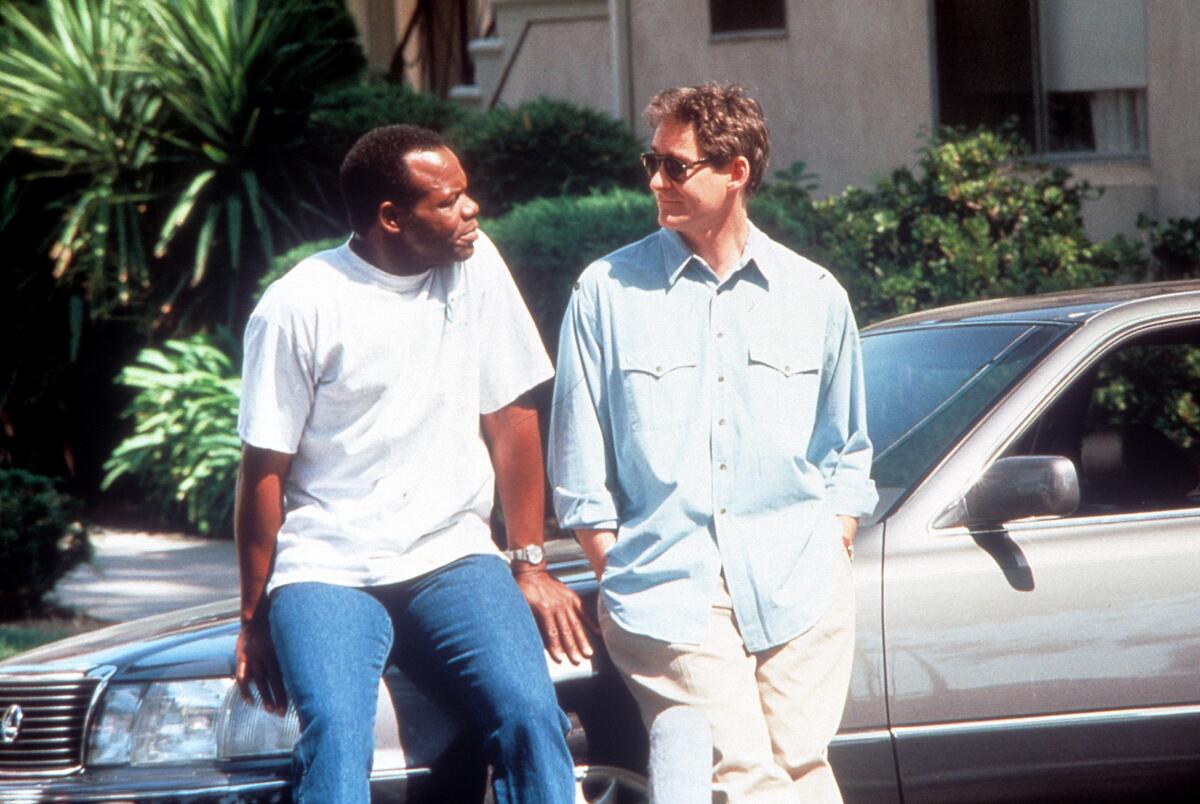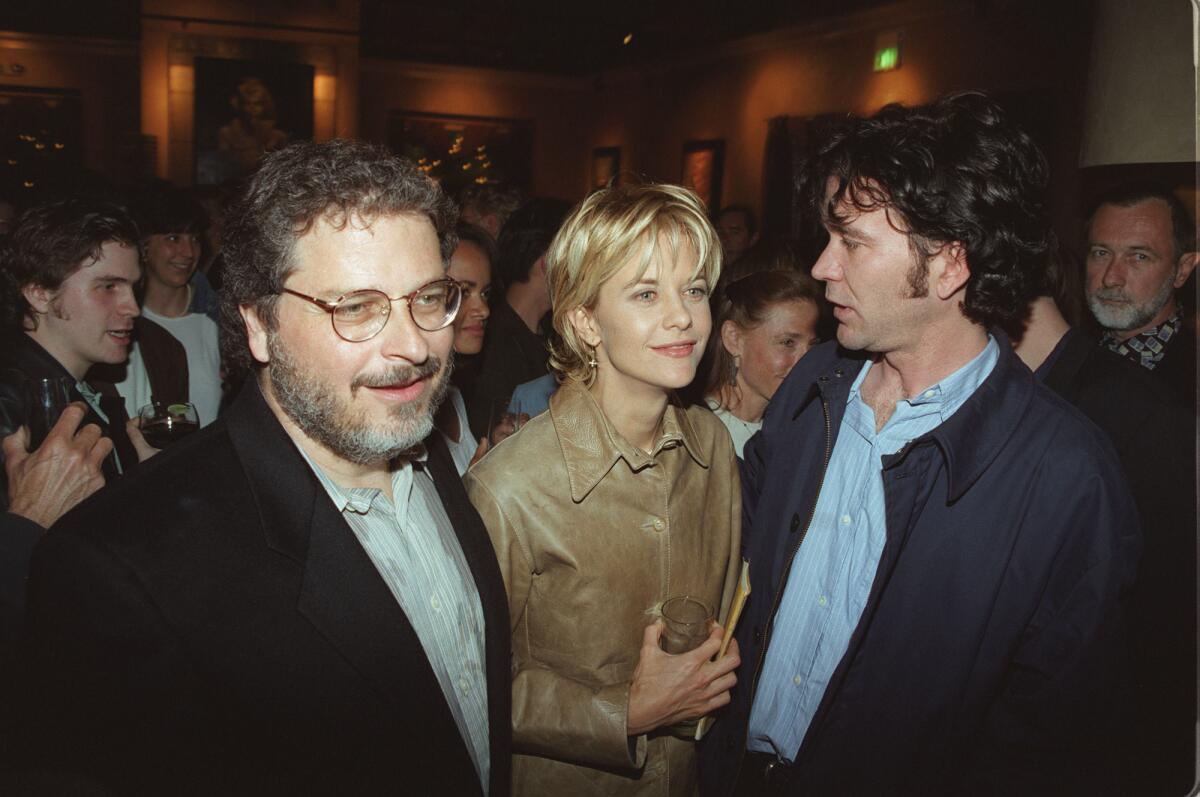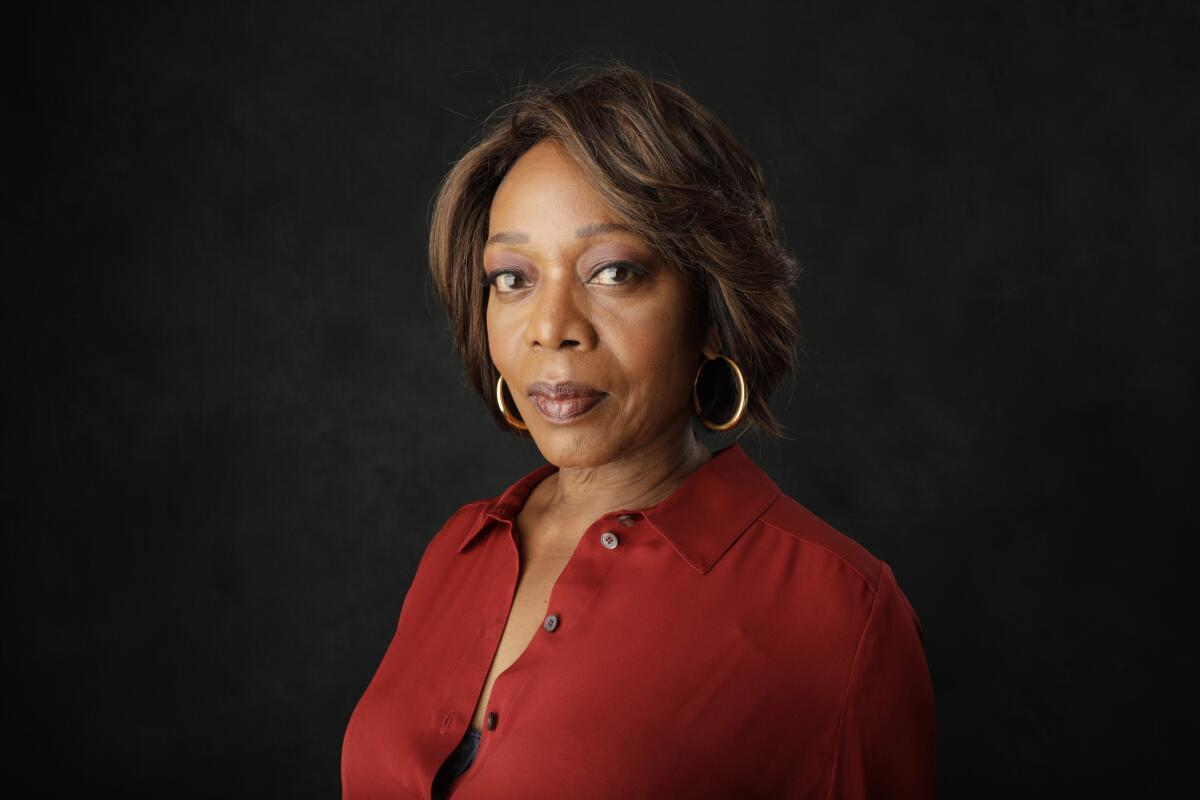Lawrence Kasdan’s L.A. story ‘Grand Canyon’ remains relevant 30 years later

- Share via
Thirty years ago this month, Lawrence Kasdan’s “Grand Canyon” came out. The film seemed almost prophetic in its examination of the fraught racial tensions in Los Angeles, the grand disconnect between privileged white residents in Brentwood and the Black Angelenos living under a military-style police presence in South L.A.
The story follows Kevin Kline’s Mack, whose car breaks down in Inglewood. His encounter with a local gang is intervened by a kind tow truck driver named Simon (Danny Glover). That sets in motion a series of interwoven storylines about characters on both sides of the “canyon” that divides L.A., with hints of miracles and a little magical realism.
The movie’s release came halfway between the night in 1991 when Rodney King was brutally beaten by four LAPD officers and the afternoon in 1992 when those cops were acquitted — lighting a fuse of outrage that set the city on fire.
When Kasdan was asked how he foresaw the 1992 riots, he would respond that “you had to be blind not to know that there were all these currents going on, and you didn’t really know what the spark of it would be,” as he recalled in a recent Zoom interview sitting next to Meg Kasdan, his co-screenwriter and wife of 50 years.
“There was an assumption that [the LAPD] could get away with anything, and they acted like that,” he said, “and that created a lot of anger within the Black community. And there was a lot of crime too. It was a big mess. So when we sat down to write ‘Grand Canyon’ ... the fact that a spark happened the next year, right after our movie came out, is just coincidence. It would have been sometime.”
Director Lawrence Kasdan is holed up in his office on the 20th Century Fox lot awaiting the release of “Grand Canyon” which opens in Los Angeles Wednesday.
For their film dubbed “‘The Big Chill’ of the ’90s,” Lawrence and Meg took a similar approach to his 1983 hit — large ensemble cast, existential themes — to examine their feelings and fears of living in L.A. at a moment when, as Mack puts it, there “just seems to be so many ways to buy it, particularly in this city.”
“I was just watching 10 minutes of it,” Kline said by phone, “and it was like ... God, I mean, the helicopters, the car breaks down, he cuts his finger, and then there’s an earthquake, and then the man next door has a heart attack. It’s pretty compact, you know, the density of little and great horrors.”
His character Mack experiences marital ennui, while Mack’s wife Claire (Mary McDonnell) dreads the empty nest; Simon’s sister Deborah (Tina Lifford) and her kids live in South-Central in constant fear of drive-by shootings; Mack’s friend Davis (Steve Martin) is a Hollywood producer of violent schlock whose worldview gets upended by a bullet to his leg; Alfre Woodard and Mary-Louise Parker play working women simply looking for love.
Using the very L.A. audio-visual motif of helicopters continually overhead, Kasdan crisscrossed between these characters and their desires and fears — divorce and eternal loneliness, losing kids to college or to gang violence, earthquakes, homelessness, even taking a left turn in an L.A. intersection. He highlighted the fact that everybody is scared of dying and everyone just wants to love and be loved.
It’s Simon who brings up the Grand Canyon after his chance encounter with Mack, as they discuss the hardships of making a life in Los Angeles. Kasdan liked the metaphor of “the immutability of the canyon” — where the characters actually drive to in the film’s finale.
“Cities change, and culture changes and habits change,” Kasdan said. “The Grand Canyon doesn’t really change, in a way that you could perceive with your eyes. Danny’s character feels that his own problems are dwarfed when he sits out there and that being dwarfed is a good thing sometimes.”
---
When the film came out in December 1991, it received mostly positive response. In his review for Time, Richard Schickel wrote that it “forces us to contemplate the fragility of our everyday arrangements, the ease with which brutal chance can void the habits and relationships we count on to give life its continuity. It is hard to think of another American movie that has so directly, even naively, confronted the basic source of our existential unease. Or done so with such easy humor and graceful sentiment.”
The Kasdans’ screenplay was nominated for an Oscar, a Golden Globe and a Writers Guild of America award, and the film won the Golden Bear at the Berlin International Film Festival. The movie earned just $41 million globally — hardly cracking the year’s top 10 or even 40, but not bad for a drama about ordinary people dealing with everyday anxiety.

Despite its modest success and social urgency, the film has been somewhat forgotten. Glover suggested that’s because people don’t like it “when the truth stares you in the face . I don’t think the industry embraced that movie in the way in which it should have.”
Kline likened it to a European art film and admitted that his own kids have never seen it. When Paul Haggis’ similarly structured and themed “Crash” came out in 2004, some critics compared the two — which Woodard always resented.
“Everybody acted like [‘Crash’] was, you know, sliced bread,” Woodard said. “It felt so manipulative and contrived. And this is just me being honest: It seemed to be told from the point of view of a person who knew it all and wanted to tell us what it was all about.” By contrast, she said, Kasdan “always was in the process of discovering. He’s a man that listens, and so he has an openness in his mind, and it leaves an openness to discover. There’s room for him to learn something — there’s room for your viewer to learn something.”
Taking inspiration from their marriage and the fact that their oldest son had, at the time, reached driver’s license age, the Kasdans poured many of their concerns and observations about life in L.A. into a dense, 132-page screenplay. The part of Mack was originally offered to Harrison Ford, but when he turned it down Kasdan went to Kline, his friend and frequent lead. The actor, who’s often been asked if his “Big Chill” character is Kasdan’s avatar, admitted there’s a fair amount of the writer in Mack — from certain phraseology (“Mayday, mayday”) to his ironic detachment from life.
“‘You trying to cheer me up?’” Kline said, quoting a line he says to Glover. “Yeah, it’s got Larry’s voice for sure.”
And McDonnell’s Claire is a reflection of Meg, down to her elaborate calendar method of organization. With her teenager (Jeremy Sisto) soon leaving home, Claire stumbles across an abandoned baby while jogging, cutting straight to her tenuous identity as a mother and making her sad about the state of the world.
Meg was also on the board of an organization supporting deaf children, which inspired her to give Glover’s character a deaf daughter who communicates with him using a teletype machine.
“You could easily say it’s a movie about finding love, and hoping for love and persevering with love,” said Lawrence Kasdan.
“And people just connecting as individuals,” added Meg. “Aside from racial identity — just making a connection to another person.”
But race is definitely one of the film’s major concerns. Woodard, Glover and Lifford all praised the Kasdans for their circumspection and collaborative spirit in how they wrote the Black characters.
“The movie absolutely captures and represents a known reality,” said Lifford, who pointed out the script’s depiction of a loving family unit existing within the depiction of South L.A. as a war zone. “It’s real! It’s healthy. Black folks have not walked the planet disconnected from love. No! And, as ‘Grand Canyon’ depicts, on top of this normalized tyranny — which speaks to the resilience of the human psyche.”
Activism* The actor used his money to save the faltering TransAfrica Forum. Now he’s devoting time and energy to rebuilding the think tank.
Kasdan “provided me with the tools I needed to work with,” said Glover. “It absolutely has a great deal of truth.”
The actor, previously in Kasdan’s western “Silverado,” was going through a similar situation with his own nephew to that of Simon and his nephew Otis, played by Patrick Malone. Standing on the porch one evening, Simon pleads with Otis not to go out with his “set.”
“You want to be gangbanging when you’re 25?” Simon asks. Otis looks at him incredulously and says: “I’ll never live to be 25.”
That was the key line Malone used to find his character. The actor grew up in a small Texas town, “but I’m still Black,” he said, and laughed. “I was one of six Blacks in my graduating class. And the difference between where I’m from and out here: Where I’m from, they would call you [the N-word] to your face, you know. They weren’t trying to gladhand you ... and then say it behind your back. Here, it was more on the DL, you know — more subtle racism.”
After Mack’s “miraculous” rescue by Simon, he helps Deborah and her family move to the “safe” suburb of Canoga Park as a show of gratitude. Otis goes for a walk in his new neighborhood and gets lost, and as he tries jogging back to the new apartment he’s stopped by cops, their guns drawn, and he is pinned to the ground.
He says the day he shot that scene in Canoga Park, he and another actor of color were stopped by an officer and told: “You don’t belong here.” Someone from the film crew came over and explained they were part of the production — and Malone said he didn’t have to search very deep when he shot his scene a few hours later.
--
James Newton Howard, the film’s composer and a longtime friend of the Kasdans, said he’s always felt Los Angeles has a sleepy quality.
“I think you can be lulled into some kind of semi-conscious state, just by the weather and by looking at palm trees,” Howard said. “Outwardly, it can seem very calm and serene.”
Part of his score, then, is full of dreamy saxophone solos. Howard, who grew up in Hawthorne, was battling Epstein-Barr Virus at the time — which can cause heavy fatigue — so “maybe that was singularly my experience,” he laughed. “But that’s one of the undercurrents that exists in L.A. There are many other undercurrents — one of them is very scary. And then some of them are very beautiful.”
Mack and Davis represent the sleepy Angelenos, the ones who live above the 10 in their large homes with neighborhood security patrols. To a great extent, “Grand Canyon” is about waking up the sleepers — one might even say “making them woke” — to their less privileged and more endangered neighbors.
Kasdan expressed doubt that he, a white man, would be able to make a film like this in 2021 — a story where a Black man rescues a white man from potential gang violence, and the white guy responds with an offer of friendship and moving the Black man’s family out of South L.A..
“I think that the movie isn’t seen much now because of that,” Kasdan said. “I think that the critical world and the culture were much more open to seeing those nuances. Today, you would not even get that far. It would be eliminated, simply by that storyline. And also, it’d be like: ‘Well, why are you making a movie about Black people?’ It’s really become much more restrictive.
“That’s not why I wanted to make movies. It’s not how I came into the business. There was a feeling you could make a movie about anything.”

Woodard notes that by collaborating with actors such as Glover — “the original Bay Area lefty, revolutionary, Black nationalist” — and practicing empathy, Kasdan’s intentions were above reproach.
“I think when your motives are correct, and you know enough to go to the people who can bring the truth to the story that you want to tell, then you tell your story,” Woodard said. “At that point, we wouldn’t see Black people on screen if people like Lawrence Kasdan were not including them into a narrative.”
“Grand Canyon” depicts Los Angeles at an especially volatile moment in 1991, but it remains relevant. The city is still racially segregated, Black folks are still getting killed by police and the gap between the haves and the have-nots has only widened.
“I think if you’re in the right mood, it’s quite a meditation on the state of the human condition,” said Kline. “And it hasn’t changed, and maybe it hasn’t changed in hundreds of years. And it’s not about to.”
If anything, the film doesn’t contain enough anxiety for today, unaware of modern existential fears such as climate change, a far worse homelessness crisis, extreme political division — so many ways to buy it.
But Malone sees one major way the city has improved since “Grand Canyon.”
“Young people’s thinking has changed,” he said. “I think that you see more mixed couples, you see kids out there marching together — gay, straight, Black, white, whatever it is. I think that is the change for L.A.”
More to Read
The biggest entertainment stories
Get our big stories about Hollywood, film, television, music, arts, culture and more right in your inbox as soon as they publish.
You may occasionally receive promotional content from the Los Angeles Times.










